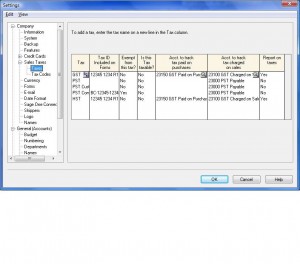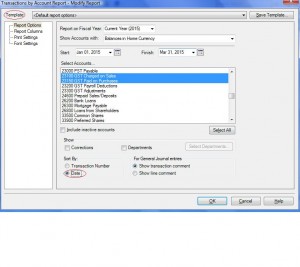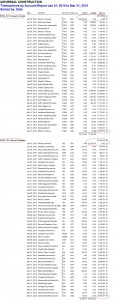GST/HST/PST Setup Tutorial
This tutorial will look at how to setup tax tables on Sage 50 Simply Accounting. Depending on where you do business your GST/HST/PST set up will be different.
Below is the home page of Sage 50 Simply Accounting Classic View.
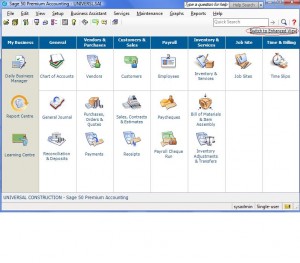 Step 1 – Create the necessary accounts in the chart of accounts. On home page click on Chart of Accounts. I have PST / GST accounts setup to track taxes. If you live in a province that collects HST create HST paid on purchases and HST charged on Sales. You do not need a PST account.
Step 1 – Create the necessary accounts in the chart of accounts. On home page click on Chart of Accounts. I have PST / GST accounts setup to track taxes. If you live in a province that collects HST create HST paid on purchases and HST charged on Sales. You do not need a PST account.
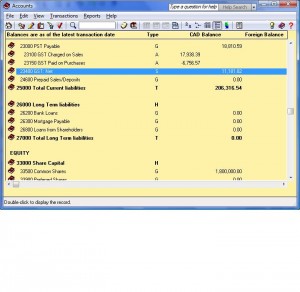 Step 2 – Now that we have our accounts created, lets create our tax table and link these accounts. From the setup menu click on Settings – Company – Sales Taxes and Taxes.
Step 2 – Now that we have our accounts created, lets create our tax table and link these accounts. From the setup menu click on Settings – Company – Sales Taxes and Taxes.
There are several colums in the setting stage. the first is the Tax Colum. Type you tax name used in your province.
Tax ID Included on Forms – type in the tax number issued to you by the government.
Exempt From this Tax? -Type No or Yes. they should all be No but in case of PST you could be exempt.
Is This Tax Taxable – Type No. There is no extra tax on top of this tax.
Acct. to track tax paid on purchases – this is where you would link the accounts you created to track taxes.
Do the same for tax charged on sales.
Reports on Taxes – You can allow Sage 50 Simply Accounting to give you a report on GST/HST to show how much taxes have to be paid to Revenue Canada or refund. I normally calculate it myself by printing reports. Watch GST Payable setup. http://www.simply-accounting-tutorial.ca/general-ledger/sage50-simply-accounting-record-gst-payable
Now that you have completed the initial set up lets go to tax codes.
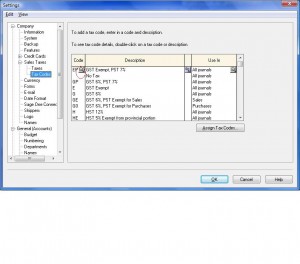 There on three colums. under Code you can type in a 3 character code to represent the tax being charged. Give it a description and choose what journal it will be used for.
There on three colums. under Code you can type in a 3 character code to represent the tax being charged. Give it a description and choose what journal it will be used for.
Now lets go deeper and issue a tax percentage to the coded.
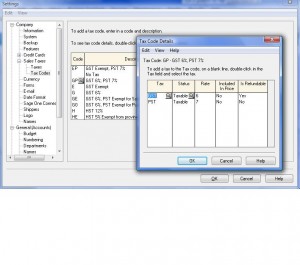 This tax is GST and PST charged on Sales. click on magnifying glass and choose GST. Status is Taxable. Rate is 6% (in this case) Included in Price is No (on the sales invoice the tax should show up on a separate line) Yes for Is refundable.
This tax is GST and PST charged on Sales. click on magnifying glass and choose GST. Status is Taxable. Rate is 6% (in this case) Included in Price is No (on the sales invoice the tax should show up on a separate line) Yes for Is refundable.
on second line choose PST. Status is Taxable. Rate is 7%. Included is price should be No (it will have to show up separately on your sales invoice). is refundable should be No (PST is not like GST and a refund will not be allowed for this tax. Once ou set up all your taxes. click Ok.
This concludes our tutorial. Let me know if you have specific questions. Click on the link ask question or leave comment.
Scroll all the way down the page.
Categories: 17- GST, HST Reports & Remittance Tags:
Sage50 Simply Accounting Record GST Payable
Hi,
I think there is some confusion around GST / HST and how to get the appropriate reports and record the liability to Revenue Canada.
Here is a tutorial on how I figured it out. I think it’s the easiest way to do it if you don’t want to use Sage 50 tax function. I like to get the GST general ledger report myself so I am sure the proper amount is being paid.
for this tutorial I will be in classic mode of Sage 50. this is the home screen.
 From the Reports menu click on financials – Transactions by Account or General ledger (depending on the version of Sage 50 you have)
From the Reports menu click on financials – Transactions by Account or General ledger (depending on the version of Sage 50 you have)
I Have some important fields circled. From the top, you can set this report as a template and give it a name. Make sure the fiscal year and the dates are within the time that you need. Mine is January to march 2015 the first quarter of GST. Some companies have yearly or monthly GST but for our purpase this is a quarterly GST remittance. pick your GST accounts and click on date. your report will be in date format and you dont want to see corrections. Click Ok.
This is your report. Make sure the balance forward is zero. in this example both GST accounts start off with a zero balance once the previous balance is recorded. Always choose the total in the balance colum to pay. this way if you make adjustments after remitting GST to Receiver General you can capture it in the next GST quarter as part of the balance colum.
You also need to report net sales. Bring up an Income Statement report by dropping down the Reports menu – financials and income statement. Make sure your date reflects the January to March GST quarter and click ok.
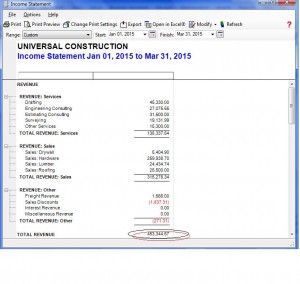 Now you know what the GST collected on sales is, the GST paid on purchases as well as net sales for the quarter. Open the purchase journal and bring up the Receiver General vendor. We need to record the liability.
Now you know what the GST collected on sales is, the GST paid on purchases as well as net sales for the quarter. Open the purchase journal and bring up the Receiver General vendor. We need to record the liability.
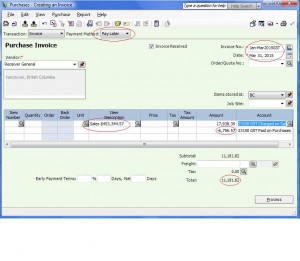 Here is how the purchase journal should be recorded. the entry should be as pay later. the invoice number should reflect the GST quarter for future reference and the date should be the last day of the GST quarter. record the net sales in description and the tricky part is to make sure to put a negative beside the amount for GST on Purchases. The net liability to Receiver General is $11,181.82.
Here is how the purchase journal should be recorded. the entry should be as pay later. the invoice number should reflect the GST quarter for future reference and the date should be the last day of the GST quarter. record the net sales in description and the tricky part is to make sure to put a negative beside the amount for GST on Purchases. The net liability to Receiver General is $11,181.82.
Hope this tutorial helped. If you a question or comment I would be happy to hear from you.
Categories: 05- Purchases, Orders & Quotes, 17- GST, HST Reports & Remittance Tags:
